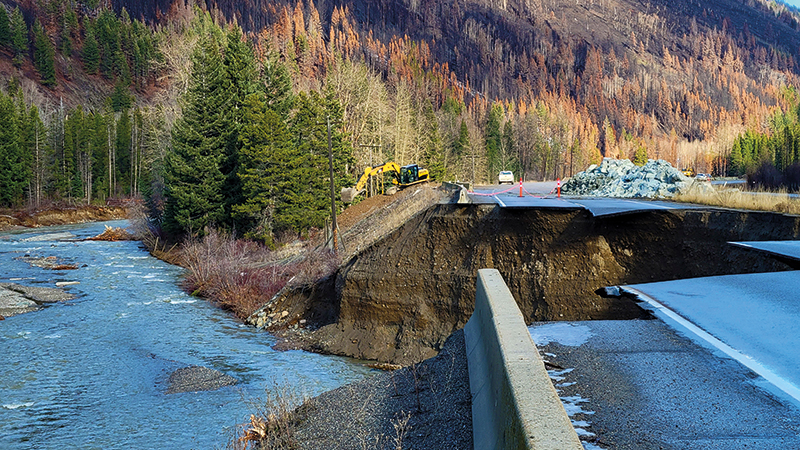By Benjamin Koczwarski
In Innisfail, Alta., the problem is rain. Specifically, too much rain: the number of “major” rain events of more than 10 mm has increased in recent years, engineering coordinator Curtis Hoffman says, causing issues with inflow and infiltration into the sanitary sewer system. Innisfail is a small municipality of 7,655 residents and doesn’t treat its own sewage, Hoffman points out. Instead, they pump it to the City of Red Deer for treatment and pay for this service based on volume. “After major rainfall events, we see a spike in that volume,” he says. “That’s unnecessary groundwater that we’re paying to treat.”
Heavy rain. Hurricanes. Floods. Wildfires. Heat waves. They’re not new issues for municipalities to cope with. But what is new is their increased frequency—and their severity. Like Innisfail, towns and cities across Canada are facing increased stress on their infrastructure as the consequences of climate change escalate. At the same time, they are looking for effective (and cost-effective) ways to cut emissions and take action to help keep global temperature increases as low as possible.
These challenges call for a new diligence when it comes to maintaining, repairing, and replacing municipal assets. In an altered and still-changing climate, old assumptions about infrastructure no longer hold water. Long-term planning needs to take climate change into account, whether it’s prepping for higher storm surges or dealing with buckling sidewalks caused by excess heat. That’s why Innisfail and other communities are developing asset management (AM) systems that are proactive on climate change, thanks in part to funding, training, and resources from the Municipal Asset Management Program (MAMP) delivered by the Federation of Canadian Municipalities (FCM) and funded by the Government of Canada. By integrating climate action into their asset management systems, these municipalities are stepping up to prepare for an uncertain future.
Partners for climate
One of these is Quispamsis, N.B., a town of about 19,000 in the Kennebecasis River valley. For this riverfront community, high water levels and floods are a risk, notes Gary Losier, who is the municipality’s director of engineering and works as well as president-elect of the American Public Works Association. While they’ve been lucky so far to avoid the extreme flooding that’s been experienced recently in many other parts of Canada, staff are keenly aware that their turn could come, and thus are building climate change predictions into their planning. “When it comes time to upgrade or adapt an asset designed back in the day for a 20- or 50-year storm, we look at how those [flood risk] scenarios have changed,” Losier says. “Replacing something like a pump station, we look at the material being chosen, the efficiency of the engines or the motors. Does it have to be designed with additional buffers or flow protection?”
Quispamsis was one of the original adopters of FCM and ICLEI Canada’s Partners for Climate Protection program, a national network of municipalities learning how to fight climate change and reduce GHG emissions and has also received support from MAMP. Therefore, Losier says, it was a natural fit for them to look at their asset management plans with a climate lens in addition to financial and operational perspectives. “That informed our decision in our initial request for proposals for asset management consultants,” he says. “It should be clear that climate change would affect how we want to deal with our different assets.”
Asset management is about “getting the most out of everything,” says Hoffman, and as such, it’s only logical to ensure that municipal plans consider a range of possible futures. Maximizing the lifespan and utility of infrastructure requires making the right purchasing and maintenance decisions, and AM systems that incorporate good data—including climate-related information—make that decision-making process more straightforward and transparent. “In the past, decisions have been made about infrastructure and facilities because a long-time employee said so, or a resident insists that the water pressure on his road is bad, says Hoffman. “Having a solid asset management program in place gives us the ability to make data-driven decisions, so when someone challenges us on why, we have that information.”
Getting started
That doesn’t mean the path is easy, though. There are several barriers to overcome to build climate-proactive asset management systems into the municipal day-to-day. One of these, of course, is the power of habit: it can be hard to overcome the inertia of established processes and to change the behaviour of staff and management accustomed to doing things a certain way, even if they’re on board in theory. Another is simply knowing where to start. The future effects of climate change are simultaneously predictable and uncertain and pose myriad new threats to municipal infrastructure. It can be challenging to know the risks and how they should affect approaches to asset management. In addition, public awareness and political support are crucial, and can’t be taken for granted. It’s important to explain how systemic improvements to asset management can save the community money and lower risks in the long term.
One method to smooth the transition is by having an asset management champion in place who can lead the charge. In Quispamsis, this is Losier, who completed an asset management course from NAMS Canada that he subsequently had two staff members take as well, with financial assistance from MAMP “You establish yourself as someone who understands the purpose of the asset management plan,” he says of the unofficial role. “You must be that point of contact for the policymakers and the operational people. You keep people moving—that goes a long way.” Hoffman agrees, and adds: “Anytime someone starts anything, it’s easy to fall back to how we were doing it before. The champion helps us keep people focusing on what’s important.”
For municipalities who want to act, the process starts with building a foundation of policies and documented practices. Establishing a cross-functional team is key, as is training them on risks and actions. And it’s important to be continually communicating and establishing means for formal communication on risk-based asset management decisions. With all of this in place, not only will communities better understand the future conditions that will affect asset performance and municipal services, but they will understand how climate change poses new threats to infrastructure and services, and better adapt their operations and investments to anticipate and limit negative effects.
For municipalities just starting with asset management, Hoffman points out that getting buy-in from the local council needs to be a priority. “It’s a long process,” he says. “The day-to-day results don’t look like they add up to a lot sometimes, but when you step back and look at two months’ worth of work, there’s progress made. If you’re just starting out, having that buy-in at the upper level is critical.” Getting involved in training programs in your region and communicating with neighbouring municipalities is a huge benefit, he adds: “Being able to talk to people and find out where they’ve stumbled and where they’ve had their successes, it’s been a benefit for the morale of our asset management program.”
Integrating climate-informed asset management is a journey, not a destination, notes Losier. “It’s ongoing. It doesn’t stop. Don’t think it’s a one and done.” He adds that every action and decision is a chance for education and to relate the process back to asset management. “Anything you do, say that it’s covered under the asset management plan or it’s part of our long-term budget. Any decisions you make, link it back to your document and your plan.” In fact, Losier was pleasantly surprised by how little push-back he and his team have received as they’ve gone through the asset management process. “If you take the time to set policies and have it on paper and explain it, it makes it a heck of a lot easier to go through,” he says.
That’s important, because the changing climate poses new risks to infrastructure, and municipalities need to be ready. The new reality will affect how assets perform in different operating conditions, presenting new hazards, and demanding that municipalities reduce their emissions from operations. This calls for changes in the data municipalities collect, the way they process it, and the decisions they make based on their understanding of the future operating environment. Innisfail, for example, is looking at ways to mitigate the effects of major rain events on their sewer infrastructure — a goal that has buy-in for several reasons. “It’s directly climate related, we’re paying extra, we’re using extra electricity. It hits a lot of boxes,” says Hoffman. “It’s dollar driven, which is easy to present to council.”
From an asset management point of view, Hoffman notes, “Climate change is going to affect everything.” That’s going to require not just updated asset management plans, but also a renewed focus on collaboration among municipalities across the country, with support from organizations like FCM and provincial and territorial municipal associations. “We’re leaning on other municipalities for some of the things we’re doing,” he says. “And if we can get out ahead of the curve and others can depend on us, we’re more than happy and excited to do so.”
[This article originally appeared in the January/February2023 edition of ReNew Canada.]
Benjamin Koczwarsk is the sector lead for FCM”s Municipal Asset Management Program.
Featured image: Towns and cities across Canada are facing increased stress on their infrastructure as the consequences of climate change escalate. (B.C. Ministry of Transportation and Infrastructure)












